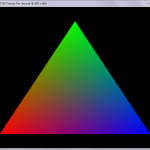JavaScript OpenGL Function Linker
If anyone is interested, here's a little jQuery/JavaScript function that replaces all OpenGL function names in your HTML document with a highlighted, clickable JavaScript link to the appropriate OpenGL manual page.
If anyone is interested, here's a little jQuery/JavaScript function that replaces all OpenGL function names in your HTML document with a highlighted, clickable JavaScript link to the appropriate OpenGL manual page.
I'm happy to inform you that "Chapter 2: Vertices and Shapes" is now available for online by clicking on this link.
Let me know if you have any issues, bugs, errors, or simply wish to yell at me. Happy reading.
The contents on OpenGLBook.com have been written explicitly with OpenGL 4.0 in mind. Just in case you were wondering why, here's the rationale.
The main reason not to go with OpenGL ≤ 3.1 was the fixed functionality that was still part of the specification. With the introduction of core and compatibility profiles, we're able to use a more pure and programmable API devoid of the CPU-intensive immediate mode operations. OpenGL 4.0 also exposes modern hardware features (tessellation, geometry shaders), which we'll explore in distant future chapters.
The downside of using the programmable pipeline is since we lose immediate mode functionality, we have to rewrite several functions from scratch. Functions such as gluLookAt and gluPerspective are no longer available to us, so we have to implement them ourselves. In the next couple of chapters, we will define some of that mathematical functionality using C, with full explanations of the mathematical operations provided.
 As promised at the end of Chapter 1, Chapter 2 deals with polygons, vertices, and geometry.
As promised at the end of Chapter 1, Chapter 2 deals with polygons, vertices, and geometry.
We're leaving the old OpenGL programming model behind by using Buffer Objects and Shaders instead of the old fixed function pipeline.
Keep on the lookout for this chapter in the near future.
I'm happy to inform you that as of today, OpenGLBook.com is live and that the first content is now available to read.
The preface to the book explains some of the history behind OpenGL as well as computer graphics in general.
The first chapter teaches how to set up an OpenGL rendering context using FreeGLUT and GLEW.
Chapters are released periodically and are announced on this very blog, so subscribe to the RSS feed if you wish to stay up-to-date on developments.
Please drop me a line if you find any errors, inconsistencies, or simply wish to yell at me, at the contact information posted on the blog (or simply leave a comment).
